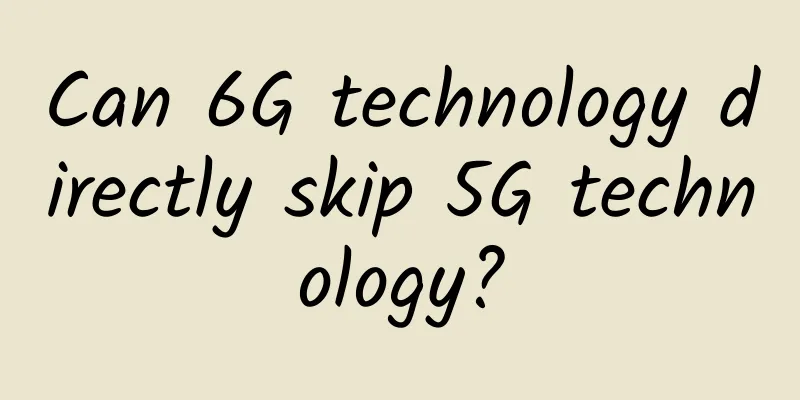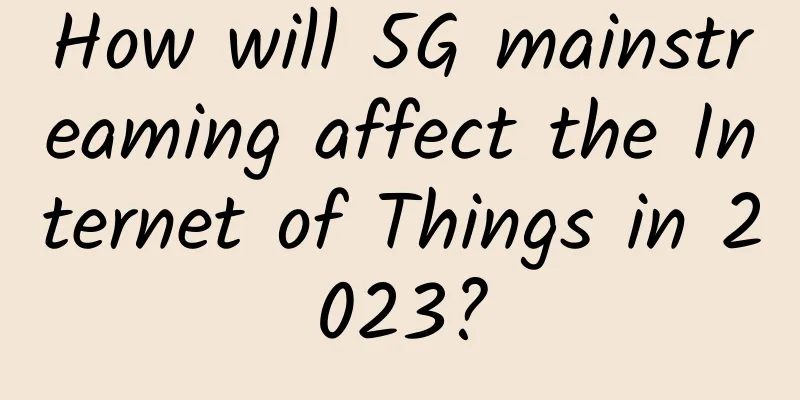Can 6G technology directly skip 5G technology?

|
1G→5G: There is precedent for skipping As far as the technological evolution of the communications industry is concerned, from 1G to the current 5G, some technical standards have evolved from the original standards, while some can be seen as completely discontinued. This may be more about interests, but there are also some that are completely discontinued due to technical reasons. The 1G era was the era of analog communication. 1G communication was a regional standard that was developed by each country. In the 2G era, GSM, which was dominated by Europe, became the most widely deployed mobile communication standard in the world. In the late 2G era, CDMA emerged and began to challenge GSM. However, in the 2G era, CDMA did not have enough capabilities to challenge GSM. In the 3G era, the three international 3G standards are completely based on CDMA. The 3G era is the era of CDMA. The main reason is technical reasons. At that time, CDMA was considered to be the only technology that could solve the problem of co-frequency multiplexing. Therefore, the three 3G standards could not circumvent CDMA technology and basically used CDMA as the core patent. However, in the middle and late stages of the 3G era, the fourth 3G international standard was proposed by the IEEE in the United States, which used its dominant position to force the ITU to reopen the standard. The fourth international standard was Wimax, which ultimately died in the communications industry. From a technical point of view, Wimax is basically a continuation of Wi-Fi technology. It can be said that it has nothing to do with the original 1/2G and is a technology that skipped 1/2G. Although Wimax died young, it showed the communications industry that OFDM technology can also solve the problem of co-frequency reuse. In addition, the "Qualcomm tax" in the 3G era made the entire communications industry suffer. Therefore, the core idea in the evolution to LTE is to "de-Qualcommize". The technical standards of LTE completely avoid most of the core technologies of 3G. Qualcomm itself also had a planned 4G technology, UMB, which was completely based on the evolution of 3G CDMA2000, but it eventually died. In the 4G era, Wimax also has subsequent evolution technology, which is another 4G standard - IEEE 802.16m. When it comes to 5G, since 3GPP has become the overlord of mobile communications, the 3GPP 5GNR standard is a further evolution of the 3GPP R10 version of 4G. Although some new technologies, new air interfaces, new spectrums, and new network frameworks are adopted, from a technical point of view, it has not skipped 4G technology and is a continuation. The IEEE is also developing corresponding 5G standards, which are expected to be submitted to IRU for approval in 2020. This is the subsequent evolution of IEEE 802.16m. To sum up, 6G can theoretically bypass 5G technology, and there are precedents in history. Whether it is necessary is another question. The biggest problem across generations: Is there a commercial scenario for 6G? At present, there is no consensus in academia and industry on what 6G is, and everyone is racking their brains to explore. From the perspective of communication history, 5G can be said to be a watershed. 2-4G has always been aimed at the embb scenario in 5G, how to make the speed as fast as possible and the more comfortable people can use it, the better. 5G takes the needs of machines into consideration for the first time, considering how to make machines comfortable and how to use them more efficiently. Therefore, urllc and mmtc scenarios came out. At present, 6G will be further extended based on 5G scenarios. Whether it is terahertz or satellite infrastructure, everyone's logic is basically the same, further enhancing the performance of 5G scenarios. Terahertz is for faster speed, and satellite is for connecting more devices. In fact, whether 6G technology can directly skip 5G technology is completely possible from a technical perspective, but whether it is necessary to skip 5G technology can be said to be "largely a matter of interest." However, the key point is that whether it can skip research and whether it can skip commercial use are two different things. There may be no barriers to skipping research, but the barriers to skipping commercial use are extremely high and difficult. For example, embb is pursuing how to obtain a larger bandwidth and a higher speed. From the perspective of communication principles, the higher the frequency band used, the larger the available bandwidth. Naturally, some people proposed terahertz for communication. Of course, the research on terahertz can skip the research on the frequency band used by 5G. The nature of the frequency band is different. To put it bluntly, it is like reading two basically different books. In fact, the study of frequency bands is never about starting from low to high. There is something called radar, and the frequency band it uses is in the broad range of millimeter waves. Radar has been around for many years, while mobile communications have only been around for a few years. So the study of frequency bands can be done in a jumpy way. However, civil and commercial applications cannot be achieved by leaps and bounds. The reason is very simple. The technology and devices need to be developed. Radar uses millimeter waves, and base stations also need to use millimeter waves. You can't make base stations the size of radars. Let's make an assumption. If more than a decade ago, everyone had drafted the current 3G, 4G, and 5G standard documents, and all the various codes and technologies in the middle had been broken through one by one and written down on paper, could they be used directly in 5G? No, we still have to take it step by step, starting from 3G. After all, being able to think of it and being able to do it are two different things. Judging from the 3G/4G standards that IEEE has been promoting, whether it is 3G Wimax (IEEE 802.16e) or 4G IEEE 802.16m, due to their own technical problems and the resistance of the original forces in the communications industry, they have basically not been deployed, or if they have been deployed, the network was later dismantled. Therefore, promoting a technical standard is actually a more important issue. In today's communications industry, 3GPP is the main player in the mobile communications sector, and it can basically be considered that 3GPP has a monopoly on mobile communications. 3GPP was originally an organization established in Europe to promote its own UMTS. Now, with the participation of communication associations from many countries, it has become a global communication patent organization. Mobile communication networks deployed around the world are now basically based on 3GPP's technical standards. After so many years of struggle, 3GPP has become a three-way competition among China, Europe and the United States. Although China's development momentum is more obvious, it is also a dynamic balance. It can be said that 3GPP represents the comprehensive interests of mobile communication equipment vendors, terminal manufacturers, and operators. It is not something that can be broken by any government or company. Wimax is a precedent. Whoever sets the standard first will seize the market Qualcomm was very powerful in the CDMA era. The United States supported the CDMA2000 standard. Europe did not want to play with the United States and developed WCDMA. China bought a Siemens pre-research project to establish a position and developed TD-SCDMA. Then Europe and China jointly resisted the US standard. China Mobile paid a lot of money, but China's mobile communication industry developed and grew. In fact, China made the most money. Huawei and ZTE became the four largest communication equipment manufacturers in the world, and a large number of communication companies in the United States and Europe went bankrupt and merged. When developing towards 4G, Qualcomm proposed UMB, the 4G standard of CDMA2000, but it failed to work and abandoned UMB. So only LTE was left. In order to develop the industrial chain, China focused on developing TDD-LTE, which actually has no direct evolutionary relationship with TD-SCDMA, but it gives people the impression that it is a Chinese standard because it contains the two letters "TD". The United States can skip 5G and go for 6G, but it must involve Europe, at least Nokia and Ericsson, and Europe's support is needed to make a breakthrough. Two of the world's four largest telecommunications equipment manufacturers are in Europe, Nokia and Ericsson together account for half of the global market (including the United States). The other two are in China, Huawei and ZTE, which account for more than 40% of the global market. The remaining less than 10% of the market belongs to Samsung, LG and other companies. Now Europe's performance on boycotting Huawei varies, and each country has its own practical interests. US: May skip 5G and transition directly to 6G According to analysis, the US may skip 5G and transition directly to 6G. The large-scale surface infrastructure capabilities required for 5G are not the US's strong point. If the US insists on doing it, it will cost a lot of money and many years to complete, and by then it will be behind the times. The characteristic of 6G is that the Internet is built on satellites, rather than optical fibers and base stations. Infrastructure work is mainly completed in space, and mainly involves satellite launch and deployment. Since the United States is a space power, with advanced deep space exploration, remote sensing, and control technologies, increasingly mature repeatable rocket technology, and advanced chip technology, it is relatively easy for the United States to directly transition to 6G. Space networking is divided into high-orbit satellites and low-orbit satellites. In fact, Boeing's solar drones are already quite mature and can fly non-stop all year round, replacing low-orbit satellites. And because there is no interference from weather changes such as rain, snow, fog and haze above 12,000 kilometers in the earth's atmosphere, visible light lasers can be used for communication between high-orbit satellites and between high-orbit satellites and drones, while radio waves can be used between drones and the ground. In addition, due to issues with spectrum usage and the U.S. government’s strategic misjudgment of prioritizing the development of 5G millimeter wave frequency band technology, the United States lags behind China in 5G technology and industry in the Sub-6GH frequency band. Compared with the 28GHz millimeter wave technology system, the Sub-6GHz technology system dominated by Chinese companies is easier to deploy on the existing mobile communication infrastructure, and because of the lower frequency band, its service coverage is 5 times that of millimeter wave technology, so it is easier to be accepted by most countries in the world. In this way, the future 5G ecosystem will be embedded with many technologies and products of Chinese companies. The United States believes that this will pose a serious cybersecurity threat to the United States' global political, economic, and military activities. Therefore, the US government has shown unprecedented strategic determination in suppressing China's 5G industry. Although there are voices in the United States suggesting that attention should be paid to the development of Sub-6GHz band 5G technology and infrastructure, it currently seems that the United States is unwilling to follow China's path in 5G technology development and may choose to continue along the millimeter wave path. At the same time, it will try to use its technological advantages in aerospace, artificial intelligence and millimeter waves to directly develop 6G mobile communications that integrate the earth and the sky and achieve cross-generational transcendence, such as the recent "Starlink" space Internet plan approved by the US FCC. |
<<: A complete set of DNS related tests in IPv6 environment
>>: HTTP 2.0 protocol interview questions that will make the interviewer tremble
Recommend
Linkerd Canary Deployment and A/B Testing
[[413903]] This guide shows you how to use Linker...
How to Unlock a Network
Application-centric networking enables their ente...
GreenCloudVPS: 50% off AMD Ryzen series VPS, available in Hong Kong/Japan/Singapore/USA
I recently received an email from GreenCloudVPS, ...
SmartHost adds block storage (large hard drive VPS), 256GB for only $1
The day before yesterday, I received an email fro...
Comprehensive analysis of the ten most critical technologies in the 5G network field
When it comes to 5G, many people's impression...
Let's talk about HTTP/3, QUIC, how do they work?
Why do we need HTTP/3? One important reason is to...
Analysis of API Gateway Selection of Several Major Cloud Vendors
1. What is an API Gateway? An API Gateway is a wa...
5G deployment plan postponed to 2021, will operators agree?
In 2020, the sudden outbreak of COVID-19 is havin...
China Mobile actively promotes the accelerated implementation of 5G innovative applications
On September 20, China Mobile held the 5G+ Innova...
BandwagonHost: DC9 triple-network CN2 GIA line replenishment annual payment of US$74, 2.5-10Gbps bandwidth CN2 GIA quarterly payment starts at US$46.7
The DC9 triple-network CN2 GIA line host of Bandw...
Changing the quality of cultural experience with 5G
Museums are vital centers of culture, education, ...
The Ministry of Industry and Information Technology announced the ten major events of 2017. Mobile data charges dropped to 26 yuan/GB.
Recently, the Ministry of Industry and Informatio...
A brief discussion on WebSocket interface testing
What is WebSocket WebSocket is a protocol based o...
RackNerd: Multi-data center VPS annual payment starts at $10, place an order to win a random blind box and get a discount
RackNerd has launched the 2022 Black Friday promo...
Learn Python network programming from scratch: Explore TCP protocol and example demonstrations!
Python is a high-level programming language with ...









